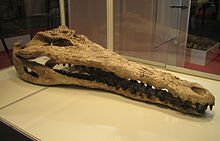Gavialosuchus
|
Gavialosuchus Temporal range: Late Oligocene - Early Pliocene |
|
|---|---|
 |
|
| Skull of Gavialosuchus americanus | |
| Scientific classification | |
| Kingdom: | Animalia |
| Phylum: | Chordata |
| Class: | Reptilia |
| Order: | Crocodilia |
| Family: | Gavialidae |
| Subfamily: | Tomistominae |
| Genus: |
†Gavialosuchus Toula and Kail, 1885 |
| Species | |
Gavialosuchus is an extinct tomistomine from the late Oligocene and Miocene of eastern North America and early Miocene of Europe. Three species have been named: the type species G. eggenburgensis from the early Miocene of Austria; G. americanus, from the late Miocene to early Pliocene of Florida; and G. carolinensis, from the late Oligocene of South Carolina. Another species, as yet unnamed, may be present in the Miocene of Georgia. Unlike its modern fresh water relatives, Gavialosuchus was an estuarine and coastal water crocodilian, living in shallow marine waters alongside Metaxytherium, Pomatodelphis, and Hemipristis serra. It was long-snouted and large: G. carolinensis was at least 5.37 meters long (17.3 ft), and one specimen of G. americanus is estimated at 9.75 meters (32.0 ft) long based on a 132 centimeters (52 in)-long skull.
As is the case with many fossil taxa, what exactly constitutes Gavialosuchus is not a settled question. Myrick Jr. (2001) proposed synonymizing G. americanus with Thecachampsa antiqua. Piras et al. (2007) advocated transferring both G. americanus and G. carolinensis to Thecachampsa as distinct species of the latter genus. Jouve et al. (2008) retained G. americanus in Gavialosuchus and found it to be the sister group of G. eggenburgensis (G. carolinensis was not discussed). However, Jouve et al. (2008) didn't test Thecachampsa antiqua in their phylogenetic analysis. Shan et al. (2009) found that G. americanus and G. eggenburgensis are not sister taxa. However, they didn't include T. antiqua and G. carolinensis in their analysis. Christopher A. Brochu and Glenn W. Storrs (2012) tested all four species, along with other crocodyloids, and found relatively strong support for Piras et al. (2007) suggestion.
...
Wikipedia
